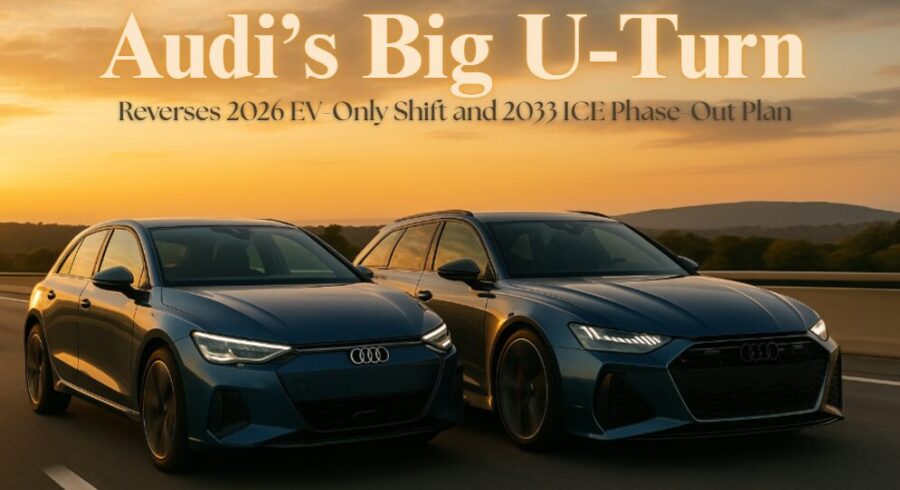Quick Overview
- Audi scraps its 2033 ICE exit and 2026 EV-only production plan
- ICE and hybrid models will continue alongside EVs until at least 2036
- Audi RS6 to offer both plug-in hybrid and fully electric versions
- New A5, Q5, Q3, and more to retain petrol, diesel, and hybrid options
Introduction: The Big U-Turn
Remember when German mammoth Audi boldly declared it would stop making combustion cars by 2033? And that by 2026, production lines would be fully electric? Well, erase that. Audi has now slammed the brakes on that timeline—and it’s not a backpedal, it’s a rethink.
Audi’s new CEO, Gernot Döllner, isn’t afraid to challenge legacy decisions. His reasoning is simple but powerful: the world isn’t shifting to EVs fast enough, and people need choices. So instead of racing to an all-electric future, Audi is now taking the scenic route—one that includes petrol engines, plug-in hybrids, and electric vehicles all sharing the road.
The Market Spoke, Audi Listened
Let’s face it—EV adoption hasn’t gone quite as fast as expected globally. Infrastructure gaps, charging anxiety, and high costs are real concerns for buyers. Döllner, in conversation with Autocar UK, called out the need for “powertrain flexibility,” and honestly, it’s a refreshingly grounded take.
Audi now plans to continue producing ICE and hybrid cars till 2030s. The roadmap includes the next-gen A5, Q5, and Q3, all featuring internal combustion engines with options for hybrid powertrains. And for those wondering: no, Audi isn’t launching an VW ID.2-sized EV alternative for now—there’s no electric A3 equivalent on the horizon either.
RS6 Gets Dual Personalities
One of the most exciting updates? The legendary Audi RS6 is going split-mode. For the first time ever, Audi will offer both a plug-in hybrid V8 and a fully electric RS6 e-tron. The decision speaks volumes about the brand’s willingness to blend performance heritage with future tech.
- The hybrid RS6 may use a 630hp 4.0L twin-turbo V8 paired with a Porsche-sourced plug-in setup.
- The RS6 e-tron, on the other hand, will ride on Volkswagen Group’s Premium Platform Electric (PPE) and feature a dual-motor system, likely producing over 550hp, tuned for serious thrills.
Well, that’s mind-boggling!
Why the Change?
Audi’s decision to reverse course comes with a commitment to evolving with the times. With tightening Euro 7 emissions norms and EV infrastructure lagging in many global markets, a mixed powertrain strategy simply makes more sense—for the environment, the economy and business viability alike.
Snapshot: Audi’s Updated Strategy (At a Glance)
| Model/Platform | Fuel Type(s) | Timeline | Notes |
|---|---|---|---|
| Audi RS6 (New Gen) | Plug-in Hybrid + Electric | Late 2025–2026 | Dual-platform: PPE for EV, PPC for ICE |
| Audi Q3 (Gen 3) | Petrol / Diesel / Hybrid | On Sale | Entry-level Audi SUV |
| Audi A5 / Q5 (New Gen) | Petrol / PHEV | 2026 | Next-gen models incoming |
| Audi A1 / Q2 | ICE | Discontinued | No successor planned |
| EV A3-sized hatch | Electric | Cancelled | No ID.2-style Audi planned |
Conclusion: A Realistic Approach
Audi’s not abandoning the electric dream—it’s just being practical about the road to get there. In a world where every buyer, market, and region moves at its own pace, choice matters more than ever. Whether it’s a V8 that growls or a dual-motor EV that glides, Audi is promising that you won’t be forced to choose until you’re ready.
Döllner’s strategy doesn’t reject progress. Instead, it embraces coexistence—of tradition and innovation, of the familiar and the future. And if that means we get to see an RS6 both light up the drag strip and whisper through the city streets? Then we say: this is the kind of flexibility the industry needs more of.

